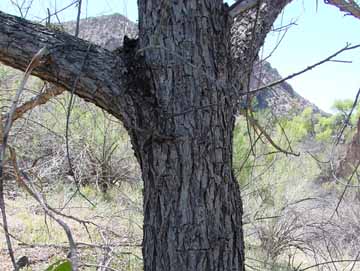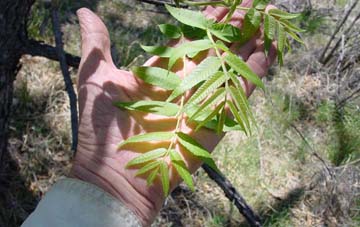
Arizona Walnut (Juglans major)

Main sources: Benson, Lyman & Robert Darrow, 1945, Trees and Shrubs of the Southwestern Deserts, Tucson: University of Arizona Press, p. 371; Petrides, George & Olivia Petrides, 1992, A Field Guide to Western Trees, pp. 66-70, Houghton-Mifflin; Hodgson, Wendy, Food Plants of the Sonoran Desert, Tucson: University of Arizona press; Zimmerman, Robert, 1969, Plant Ecology of an Arid Basin Tres Alamos-Redington Area Southeastern Arizona, Geological Survey Professional Paper 485-D, Washington, D.C.; see also the USDA Forest Service Database.
Among the other deciduous, broad-leaved riparian trees with which it is found in our area, the Arizona Walnut (the only walnut species to occur in the desert) is present in low frequency. (Its primary area of distribution is in Mexico.) It may grow to 65 feet and 4 feet in diameter, but the ones in our area are relatively small. It grows rather slowly but is long-lived (up to 400 years old), and has a well-developed taproot. Since its seedlings are susceptible to drought, we find it mainly in wet streambank locations, for example see the banner image in Sierra Blanca Spring. and it is found in Upper Hot Springs Canyon, as you see below: (click on each image to enlarge it)
Leaves are large (9-13" long), alternately pinnate, with 5 to 15 pairs of leaflets (1-4" long) & a terminal leaflet, each lanceolate. They are saw-toothed on the margins (see this somewhat more clearly in the enlargement of the image above-right, and also in the enlarged image at left below). Furrowed, scaly bark helps identify the tree. Both of the long, drooping male and female catkins appear on the same tree.
According to Zimmerman's 1969 plant distribution map, Arizona Walnut is limited to Hot Springs Canyon in the Saguaro Juniper area, stretching upstream beyond our lands to Hooker's Hot Springs on the Muleshoe Reserve and further upstream. It also occurs along most of the reach of Paige Canyon and along the San Pedro River in the vicinity of Soza Canyon downstream from Cascabel.
 At left, a green walnut takes shape on June 01, 2004. The smooth outer husk conceals a hard inner nut that can be broken for its sweet-tasting meats. The nuts were enjoyed by Native Americans as well, but in our area the trees were apparently too rare for a close relationship to develop. Apaches in the Mogollon Rim uplands collected walnut meats in September, pounded the fruits to remove the hulls, removed and further pounded the nutmeats, and mixed the meal with juices from roasted mescal. (Click on the image to enlarge it.)
At left, a green walnut takes shape on June 01, 2004. The smooth outer husk conceals a hard inner nut that can be broken for its sweet-tasting meats. The nuts were enjoyed by Native Americans as well, but in our area the trees were apparently too rare for a close relationship to develop. Apaches in the Mogollon Rim uplands collected walnut meats in September, pounded the fruits to remove the hulls, removed and further pounded the nutmeats, and mixed the meal with juices from roasted mescal. (Click on the image to enlarge it.)
For more detailed images of walnut characteristics, Click here.

